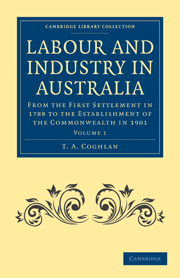 Labour and Industry in Australia
Labour and Industry in Australia Published online by Cambridge University Press: 05 August 2011
During the first few years of settlement nothing could have seemed less likely than that the production of wool would ever become the most important industry of Australia. It seemed rather that the climate and other natural conditions of the country were fatal to the miserable sheep, which found themselves driven ashore to wander on the scrubby hills about the anxious little settlement. Forty-four sheep were landed from the First Fleet in 1788. Sickness attacked them immediately, and they were greatly worried by the dingoes, so that at the end of three months fifteen were dead, and the mischief continued until only one was left. However, greater care was taken of later importations, and it was found that sheep might be bred with some success, even in the moist coastal regions about Sydney, though many died of foot-rot and water in the head.
In the year 1791 there came to Sydney with the New South Wales Corps one Captain John Macarthur, a freshcomplexioned, handsome soldier with blue eyes and auburn hair. The son of a Plymouth tradesman, he had married the daughter of a gentleman farmer, and had himself engaged in farming in England. At one time he had held a commission in the Militia, but had resolved to transfer himself to New South Wales as an officer in the newly formed Corps. He was a man of great business ability, with a remarkable aptitude for farming, and in this pursuit he was admirably seconded by his wife.
To save this book to your Kindle, first ensure no-reply@cambridge.org is added to your Approved Personal Document E-mail List under your Personal Document Settings on the Manage Your Content and Devices page of your Amazon account. Then enter the ‘name’ part of your Kindle email address below. Find out more about saving to your Kindle.
Note you can select to save to either the @free.kindle.com or @kindle.com variations. ‘@free.kindle.com’ emails are free but can only be saved to your device when it is connected to wi-fi. ‘@kindle.com’ emails can be delivered even when you are not connected to wi-fi, but note that service fees apply.
Find out more about the Kindle Personal Document Service.
To save content items to your account, please confirm that you agree to abide by our usage policies. If this is the first time you use this feature, you will be asked to authorise Cambridge Core to connect with your account. Find out more about saving content to Dropbox.
To save content items to your account, please confirm that you agree to abide by our usage policies. If this is the first time you use this feature, you will be asked to authorise Cambridge Core to connect with your account. Find out more about saving content to Google Drive.